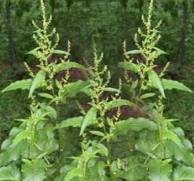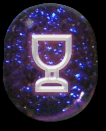Dock
The term Dock is botanically a noun of multitude, meaning originally a bundle of hemp, and corresponding to a similar word signifying a flock. It became in early times applied to a wide-spread tribe of broad-leaved wayside weeds. They all belong to the botanical order of Polygonaceoe, or "many kneed" plants, because, like the wife of Yankee Doodle, famous in song, they are "double-jointed.
Added Jul 11, 2010
| 9,405 Reads
The name "Dock" was first applied to the Arctium Lappa, or Bur-dock, so called because of its seed-vessels becoming frequently entangled by their small hooked spines in the wool of sheep passing along by the hedge-rows. Then the title got to include other broad-leaved herbs, all of the Sorrel kind, and used in pottage, or in medicine. Of the Docks which are here recognized, some are cultivated, such as Garden Rhubarb, and the Monk's Rhubarb, or herb Patience, an excellent pot herb; whilst others grow wild in meadows, and by river sides, such as the round-leafed Dock (Rumex obtusifolius), the sharp-pointed Dock (Rumex acutus), the sour Dock (Rumex acetosus), the great water Dock (Rumex hydrolapathum), and the bloody-veined Dock (Rumex sanguineus). All these resemble our garden rhubarb more or less in their general characteristics, and in possessing much tannin. Most of them chemically furnish "rumicin," or crysophanic acid, which is highly useful in several chronic diseases of the skin among scrofulous patients. The generic name of several Docks is rumex, from the Hebrew rumach, a "spear"; others arc called lapathum, from the Greek verb lapazein, to cleanse, because they act medicinally as purgatives. The common wayside Dock (Rumex obtusifolius) is the most ordinary of all the Docks, being large and spreading, and so coarse that cattle refuse to eat it. The leaves are often applied as a rustic remedy to burns and scalds, and are used for dressing blisters. Likewise a popular cure for nettle stings is to rub them with a Dock leaf, saying at the same time:— "Out nettle: in Dock; "Nettle out: Dock in; A tea made from the root was formerly given for the cure of boils, and the plant is frequently called Butterdock, because its leaves are put into use for wrapping up butter. This Dock will not thrive in poor worthless soil; but its broad foliage serves to lodge the destructive turnip fly. The root when dried maybe added to tooth powder. It was under the broad leaf of a roadside Dock that Hop o' My Thumb, famous in nursery lore, sought refuge from a storm, and was unfortunately swallowed whilst still beneath the leaf by a passing hungry cow. The herb Patience, or Monk's Rhubarb (Rumex alpinus), a Griselda among herbs, may be given with admirable effect in pottage, as a domestic aperient, "loosening the belly, helping the jaundice, and dispersing the tympany." This grows wild in some parts, by roadsides, and near cottages, but is not common except as a cultivated herb ill the kitchen-garden, known as "Patience-dock." It is a remarkable fact that the toughest flesh-meat, if boiled with the herb, or with other kindred docks, will become quite tender. The name Patience, or Passions, was probably from the Italian Lapazio, a corruption of Lapathum, which was mistaken for la passio, the passion of Christ. Our Garden Rhubarb is a true Dock, and belongs to the "many-kneed," buckwheat order of plants. Its brilliant colouring is due to varying states of its natural pigment (chlorophyll), in combination with oxygen. For culinary purposes the stalk, or petiole of the broad leaf, is used. Its chief nutrient property is glucose, which is identical with grape-sugar. The agreeable taste and odour of the plant are not brought out until the leaf stalks are cooked. It came originally from the Volga, and has been grown in this country since 1573. The sour taste of the stalks is due to oxalic acid, or rather to the acid oxalate of potash. This combines with the lime elaborated in the system of a gouty person (having an "oxalic acid" disposition), and makes insoluble and injurious products which have to be thrown off by the kidneys as oxalate crystals, with much attendant irritation of the general system. Sorrel (Rumex acetosus) acts with such a person in just the same way, because of the acid oxalate of potash which it contains. Garden Rhubarb also possesses albumen, gum, and mineral matters, with a small quantity of some volatile essence. The proportion of nutritive substance to the water and vegetable fibre is very small. As an article of food it is objectionable for gouty persons liable to the passage of highly coloured urine, which deposits lithates and urates as crystals after it has cooled; and this especially holds good if hard water, which contains lime, is drunk at the same time. The round-leaved Dock, and the sharp-pointed Dock, together with the bloody-veined Dock (which is very conspicuous because of its veins and petioles abounding in a blood-coloured juice), make respectively with their astringent roots a useful infusion against bleedings and fluxes; also with their leaves a decoction curative of several chronic skin diseases. The Rumex acetosus (Sour Dock, or Sorrel), though likely to disagree with gouty persons, nevertheless supplies its leaves as the chief constituent of the Soupe aux herbes, which a French lady will order for herself after a long and tiring journey. Its title is derived as some think, from struma, because curative thereof. This Dock further bears the names of Sour sabs, Sour grabs, Soursuds, Soursauce, Cuckoo sorrow, and Greensauce. Because of their acidity the leaves make a capital dressing with stewed lamb, veal, or sweetbread. Country people beat the herb to a mash, and take it mixed with vinegar and sugar as a green sauce with cold meat. When boiled by itself without water it serves as an excellent accompaniment to roast goose or pork instead of apple sauce. The root of Sorrel when dried has the singular property of imparting a fine red colour to boiling water, and it is therefore used by the French for making barley water look like red wine when they wish to avoid giving anything of a vinous character to the sick. In Ireland Sorrel leaves are eaten with fish, and with other alkalescent foods. Because corrective of scrofulous deposits, Sorrel is specially beneficial towards the cure of scurvy. Applied externally the bruised leaves will purify foul ulcers. Says John Evelyn in his noted Acetaria (1720), "Sorrel sharpens the appetite, assuages heat, cools the liver and strengthens the heart; it is an antiscorbutic, resisting putrefaction, and in the making of sallets imparts a grateful quickness to the rest as supplying the want of oranges and lemons. Together with salt it gives both the name and the relish to sallets from the sapidity which renders not plants and herbs only, but men themselves, and their conversations pleasant and agreeable. But of this enough, and perhaps too much! lest while I write of salts and sallets I appear myself insipid." The Wood Sorrel (Oxalis acetosella) is a distinct plant from the Dock Sorrel, and is not one of the Polygonaceoe, but a geranium, having a triple leaf which is often employed to symbolise the Trinity. Painters of old [162] placed it in the foreground of their pictures when representing the crucifixion. The leaves are sharply acid through oxalate of potash, commonly called "Salts of Lemon," which is quite a misleading name in its apparent innocence as applied to so strong a poison. The petals are bluish coloured, veined with purple. Formerly, on account of its grateful acidity, a conserve was ordered by the London College to be made from the leaves and petals of Wood Sorrel, with sugar and orange peel, and it was called Conserva lujuoe. The Burdock (Arctium lappa) grows very commonly in our waste places, with wavy leaves, and round heads of purple flowers, and hooked scales. From the seeds a medicinal tincture is made, and a fluid extract, of which from ten to thirty drops, given three times a day, with two tablespoonfuls of cold water, will materially benefit certain chronic skin diseases (such as psoriasis), if taken steadily for several weeks, or months. Dr. Reiter of Pittsburg, U.S.A., says the Burdock feed has proved in his hands almost a specific for psoriasis and for obstinate syphilis. The tincture is of special curative value for treating that depressed state of the general health which is associated with milky phosphates in the urine, and much nervous debility. Eight or ten drops of the reduced tincture should be given in water three times a day. The root in decoction is an excellent remedy for other skin diseases of the scaly, itching, vesicular, pimply and ulcerative characters. Many persons think it superior to Sarsaparilla. The burs of this Dock are sometimes called "Cocklebuttons," or "Cucklebuttons," and "Beggarsbuttons." Its Anglo-Saxon name was "Fox's clote." Boys throw them into the air at dusk to catch bats, which dart at the Bur in mistake for a moth or fly; then becoming entangled with the thorny spines they fall helplessly to the ground. Of the botanical names, Arctium derived from arktos, a bear, in allusion to the roughness of the burs; and Lappa is from labein, to seize. Other appellations of the herb are Clot-bur (from sticking to clouts, or clothes), Clithe, Hurbur, and Hardock. The leaves when applied externally are highly resolvent for tumours, bruises, and gouty swellings. In the Philadelphia Recorder for January, 1893, a striking case is given of a fallen womb cured after twenty years' duration by a decoction of Burdock roots. The liquid extract acts as an admirable remedy in some forms (strumous) of longstanding indigestion. The roots contain starch; and the ashes of the plant burnt when green yield carbonate of potash abundantly, with nitre, and inulin. The Yellow Curled Dock (Rumex crispus), so called because its leaves are crisped at their edges, grows freely in our roadside ditches, and waste places, as a common plant; and a medicinal tincture which is very useful is made from it before it flowers. This is of particular service for giving relief to an irritable tickling cough of the upper air-tubes, and the throat, when these passages are rough and sore, and sensitive to the cold atmosphere, with a dry cough occurring in paroxysms. It is likewise excellent for dispelling any obstinate itching of the skin, in which respect it was singularly beneficial against the contagious army-itch which prevailed during the last American war. It acts like Sarsaparilla chiefly, for curing scrofulous skin affections and glandular swellings. To be applied externally an ointment may be made by boiling the root in vinegar until the fibre is softened, and by then mixing the pulp with lard (to which some sulphur is added at times). In all such cases of a scrofulous sort from five to ten drops of the tincture should be given two or three times a day with a spoonful of cold water. Rumicin is the active principle of the Yellow Curled Dock; and from the root, containing chrysarobin, a dried extract is prepared officinally, of which from one to four grains may be given for a dose in a pill. This is useful for relieving a congested liver, as well as for scrofulous skin diseases. "Huds," or the great Water Dock (Rumex hydrolapathum) is of frequent growth on our river banks, bearing numerous green flowers in leafless whorls, and being identical with the famous Herba Britannica of Pliny. This name does not denote British origin, but is derived from three Teuton words, brit, to tighten: tan, a tooth; and ica, loose; thus expressing its power of bracing up loose teeth and spongy gums. Swedish ladies employ the powdered root as a dentifrice; and gargles prepared therefrom are excellent for sore throat and relaxed uvula. The fresh root must be used, as it quickly turns yellow and brown in the air. The green leaves make a capital application for ulcers of the legs. They possess considerable acidity, and are laxative.
Added Jul 11, 2010
| 9,405 Reads
Share The Magic ...
The GoE MONEY!!! Course - A Course In Real MONEY MAGIC!
|





















